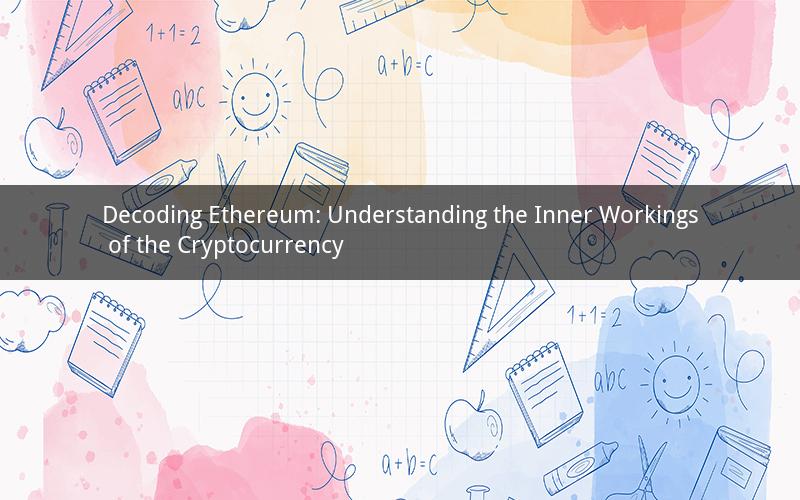
Ethereum, one of the most prominent cryptocurrencies in the market, has been captivating the attention of investors, developers, and enthusiasts alike. Its unique features and potential for innovation have made it a favorite among blockchain enthusiasts. But how does Ethereum cryptocurrency work? Let's dive into the fascinating world of Ethereum and uncover its intricate workings.
1. Blockchain Technology
Ethereum operates on the same underlying technology as Bitcoin, known as blockchain. A blockchain is a decentralized, distributed ledger that records transactions across multiple computers. This technology ensures transparency, security, and immutability, making it an ideal foundation for cryptocurrencies.
2. Smart Contracts
One of Ethereum's most groundbreaking features is the concept of smart contracts. A smart contract is a self-executing contract with the terms of the agreement directly written into lines of code. Once deployed, these contracts run automatically and enforce the terms of the agreement without the need for intermediaries.
Smart contracts have numerous applications, including decentralized finance (DeFi), supply chain management, and digital identity verification. They enable trustless interactions, where parties can engage in transactions without the fear of fraud or manipulation.
3. The Ethereum Virtual Machine (EVM)
The Ethereum Virtual Machine (EVM) is the runtime environment for smart contracts on the Ethereum network. It allows developers to deploy and execute code on the Ethereum blockchain. The EVM operates on a stack-based virtual machine, which is capable of executing complex programs and processing transactions.
The EVM plays a crucial role in Ethereum's ecosystem, as it enables the development of decentralized applications (DApps) that can interact with the blockchain. These DApps can range from decentralized exchanges to decentralized social media platforms.
4. Gas and Fees
When executing a transaction or deploying a smart contract on the Ethereum network, users must pay a fee known as "gas." Gas is the unit of measurement for the computational work performed on the Ethereum blockchain. It ensures that the network remains decentralized and secure.
The gas fee is determined by the complexity of the transaction or smart contract and the current network congestion. Users must have enough gas tokens (ETH) in their wallet to cover the transaction fees.
5. Proof of Work vs. Proof of Stake
Ethereum initially used the Proof of Work (PoW) consensus mechanism, similar to Bitcoin. However, this mechanism has several drawbacks, including high energy consumption and slow transaction speeds.
To address these issues, Ethereum is transitioning to a Proof of Stake (PoS) consensus mechanism. In PoS, validators are chosen to create new blocks based on the number of tokens they hold and are willing to "stake" as collateral.
The transition to PoS will significantly reduce energy consumption and improve network scalability. It is expected to be completed by 2022.
6. Ethereum 2.0
Ethereum 2.0 is a major upgrade to the Ethereum network that aims to address the limitations of the current PoW system. The upgrade includes the transition to PoS, sharding, and improved scalability.
Sharding is a technique that divides the Ethereum network into smaller, more manageable pieces, known as "shards." This will allow the network to process more transactions per second and reduce the cost of executing smart contracts.
7. Future of Ethereum
Ethereum has the potential to revolutionize various industries, from finance to supply chain management. As the network continues to evolve, it is expected to see increased adoption and integration with existing systems.
However, Ethereum faces several challenges, including regulatory scrutiny, competition from other blockchain platforms, and the ongoing transition to PoS. Despite these challenges, Ethereum remains a leading cryptocurrency with a bright future.
Questions and Answers:
1. What is the difference between a regular contract and a smart contract?
Answer: A regular contract requires intermediaries to enforce the terms, while a smart contract is self-executing and automatically enforces the terms without intermediaries.
2. How does the Ethereum Virtual Machine (EVM) work?
Answer: The EVM is a runtime environment for smart contracts on the Ethereum network. It operates on a stack-based virtual machine and allows developers to deploy and execute code on the blockchain.
3. What is the purpose of gas in Ethereum?
Answer: Gas is the unit of measurement for the computational work performed on the Ethereum blockchain. It ensures that the network remains decentralized and secure by requiring users to pay for transactions and smart contract executions.
4. How does the Proof of Stake (PoS) consensus mechanism differ from Proof of Work (PoW)?
Answer: PoS requires validators to "stake" tokens as collateral, while PoW requires miners to compete to solve complex mathematical puzzles. PoS is more energy-efficient and has the potential to improve network scalability.
5. What is the significance of Ethereum 2.0?
Answer: Ethereum 2.0 is a major upgrade to the Ethereum network that aims to address the limitations of the current PoW system. It includes the transition to PoS, sharding, and improved scalability, which will enhance the network's capabilities and potential for adoption.